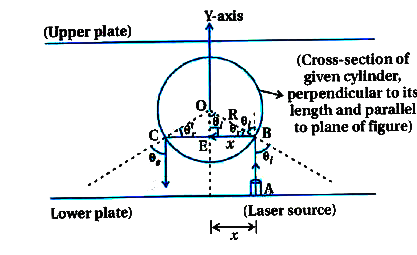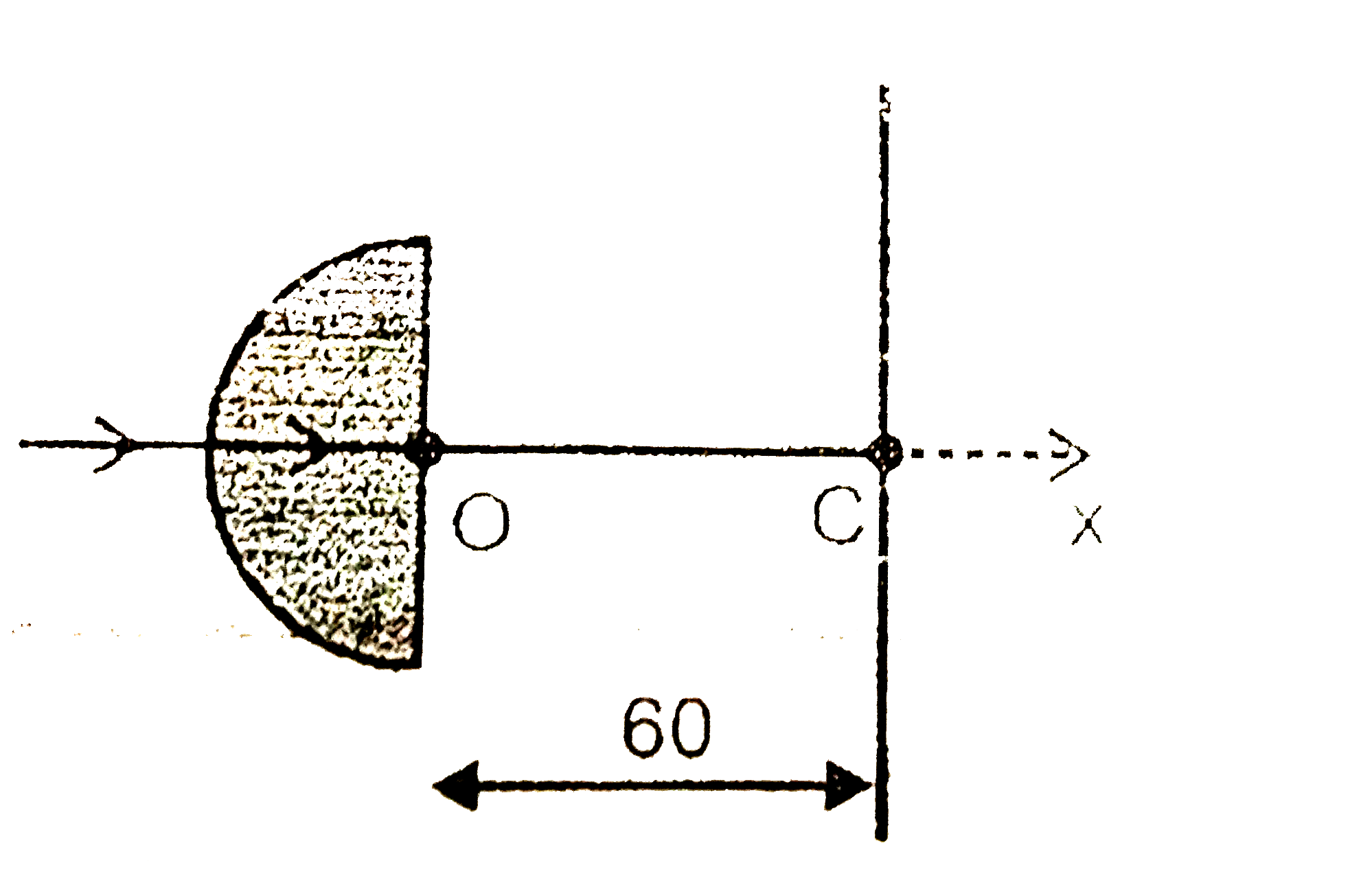An infinitely long cylinder of radius R is made of an unusual exotic material with refractive index-1 (see figure). The cyliner is palced between two planes whose normals are along the y- direction . The center of the cylinder O lies along the y - axis . A narrow laser beam is directed along the y direction from the lower plate. The laser source is at a horizontal distance x from the diameter in the y - direction.
Find the range of x such that light emitted from the lower plane does not reach the upper plane.
 Solution in Gujrati
Solution in Gujrati
⇒ For a material with negative refractive index, from of Snell.s law, is,
−n=sinθisinθr
∴−(−1)=sinθisinθr
∴sinθi=sinθr
∴θi=sinθr
⇒ Since two interior angles made by a chord of a circle with its centre are equal, we can write for above figure,
θr=θr
⇒ Now, applying Snell.s law at point C, we get
θ.r=θe
⇒ Thus, in magnitudes θi=θr=θ.r=θe
⇒ Here, incident ray −−→AB, first gets deviated by angle 2θi at first point of incidence B and then again it gets deviated by another angle 2θi at second point of incidence C. Thus, it undergoes total deviation by angle 4θi (Here sinθi=sinθr) and so we can consider as if incident light ray undergoes reflection instead of refraction.
⇒ Now, angle 4θi measured clockwise with respect to Y - axis is such that (in radian),
π2<4θi≤3π2......(1)
then emergent light does not reach to upper plate. Now, for the right angled ΔOEB, since angle θi is extremely small.
sinθi≈θi=xR.....(2)
⇒ From equation (1),
π8<θi≤3π8
∴π8<xR≤3π8
⇒ Multiplying by R,
πR8≤x≤3πR8 ......(3)
⇒ Above result is required result.
Topper's Solved these Questions
- RAY OPTICS AND OPTICAL INSTRUMENTSBOOK - KUMAR PRAKASHANCHAPTER - RAY OPTICS AND OPTICAL INSTRUMENTSEXERCISE - SECTION-D (MULTIPLE CHOICE QUESTIONS (MCQs))(MCQs FROM .DARPAN. BASED ON TEXTBOOK)
26 Videos
- RAY OPTICS AND OPTICAL INSTRUMENTSBOOK - KUMAR PRAKASHANCHAPTER - RAY OPTICS AND OPTICAL INSTRUMENTSEXERCISE - SECTION-D (MULTIPLE CHOICE QUESTIONS (MCQs))(MCQs FROM .DARPAN. BASED ON TEXTBOOK)(REFRACTION)
32 Videos
- RAY OPTICS AND OPTICAL INSTRUMENTSBOOK - KUMAR PRAKASHANCHAPTER - RAY OPTICS AND OPTICAL INSTRUMENTSEXERCISE - SECTION-C (NCERT EXEMPLAR SOLUTION) (SHORT ANSWER TYPE QUESITONS)
6 Videos
- MOVING CHARGES AND MAGNETISMBOOK - KUMAR PRAKASHANCHAPTER - MOVING CHARGES AND MAGNETISMEXERCISE - SECTION D (MCQs ASKED IN COMPETITIVE EXAMS)
34 Videos
- SAMPLE QUESTION PAPER BOOK - KUMAR PRAKASHANCHAPTER - SAMPLE QUESTION PAPER EXERCISE - PART-B SECTION-C
5 Videos
Similar Questions
Diameter of spherical mirror is 10 cm, what will be aperture of mirror ?
View SolutionRefraction index of medium-2 with respect to medium-1 is ...... .
View SolutionA short object of length L is placed along the principal axis of a concave mirror away from focus. The object distance is u. If the mirror has a focal length f, what will be the length of the image ? You may take L<<|v−f|.

View SolutionElectric charge Q having mass M moves on a circular path of radius R with velocity →v, perpendicular to uniform magnetic field B. When a particle completes one revolution, work done by the field is _______
View SolutionTwo charges –q and +q are located at points (0, 0, –a) and (0, 0, a), respectively.
(a) What is the electrostatic potential at the points (0, 0, z) and (x, y, 0) ?
(b) Obtain the dependence of potential on the distance r of a point from the origin when r/a>>1 .
(c) How much work is done in moving a small test charge from the point (5,0,0) to (–7,0,0) along the x-axis? Does the answer change if the path of the test charge between the same points is not along the x-axis?
View SolutionAxis of a solid cylinder of infinite length and radius R lies along y-axis. It carries a uniformly distributed current I along +y direction. Magnetic field at a point (R//2, y, R//2) is
View SolutionAn infinitely long cylinder of radius R is made of an unusal exotic material with refractive index (−1), Fig. The cylinder is placed between two planes whose normals are along the y direction. The center of the cylinder O lies along the y-axis. A narrow laser beam is directed along the y-direction from the lower plate. The laser source is at a horizontal distance x from the diameter in the y direction. Find the range of x such that light emmited from the lower plane does not reach the upper plane.
 .
.
View SolutionA beam of alpha particles projected along + x-axis, experiences a force due to a magnetic field along the +y-axis figure. What is the direction of magnetic field.
View SolutionIf force vector is along X-axis and radius vector is along Y-axis then the direction of torque is
View SolutionA magnetic field is produce and directed along y- axis. A magnet is placed along y- axis. The direction of torque on the magnet is
View SolutionAn electron moving with a uniform velocity along the positive x-direction enters a magnetic field directed along the positive y-direction. The force on the electron is directed along
View SolutionA proton is moving along the negative direction of X-axis in a magnetic field directed along the positive direction of Y-axis. The proton will be deflected along the negative direction of
View SolutionFigure shows a solid transport semi cylinder of radius 10 cm . A screen is placed at a distance 60 cm from O . A narrow beam is incident along X- axis at O . If cylinder starts rotating about O in clockwise direction with angular speed 6 rad//s spot formed on screen will move upward (Refractive index of material of cylinder =(5)/(3) ) What is initial angular velcity of ray refrected from plane surface.
View SolutionFigure shows a solid transport semi cylinder of radius 10cm. A screen is placed at a distance 60cm from O. A narrow beam is incident along X−axis at O. If cylinder starts rotating about O in clockwise direction with angular speed 6rad/s spot formed on screen will move upward (Refractive index of material of cylinder=53)

At waht distance from C bright spot on screen will disappear.
View Solutionएक इलेक्ट्रान पुंज जो X अक्ष के अनुदिश गतिमान है, चुंबकीय क्षेत्र द्वारा Y-अक्ष के अनुदिश विस्थापित होता है। चुंबकीय क्षेत्र किस दिशा में है?
View Solution
